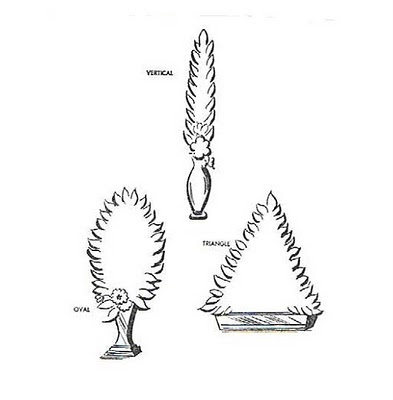
In their book, Arranging Flowers for the Sanctuary (1961), Knight and St. Claire had this to say on the topic of scale, proportion, and balance in church flower arrangements:
"Selecting and arranging plant material has two aims: order and beauty. The arranger must keep these two goals uppermost and observe known principles for their attainment.Source:
"The most often confused of such principles are scale and proportion. Both are important in successful flower arranging.
"Scale is the relationship between the sizes of the component parts of an arrangement. The relative sizes of the flowers as well as the relationship between the arrangement and the size of the area it decorates are both involved. A well-scaled arrangement for a smaller chapel would be based on Fashion roses rather than an amaryllis. Also, an amaryllis is much too large for a vertical container six inches in height.
"Proportion is the size relationship of one portion of the arrangement to another. Remember that the visual weight of plant material has much to do with the height of an arrangement. Heavy material used in a ratio of one and a half to twice the height of the container is the general rule. Light, airy material may be from two and a half to three time the height of the container and still be in proper proportion. However, if the church is large, distance tends to make arrangements diminish in height. A better appearance is attained if the plant material is at least three times the height of the container.
"Balance is another important principle, especially in church flower arranging, since the finished design must be firmly fixed. There are two types of balance. Symmetrical balance is the most common in churches. It is always quiet, dignified, and impressive, if sometimes static. This type of balance is achieved by placing an equal amount of plant material on both sides of an imaginary center line drawn through the middle of the plant material and container. Both sides are practically the same.
"The second type of balance, and one more difficult to complete, is asymmetrical. This type relies on purely visual effects for its success. The two sides here may differ in form and color but have equal weight. At all times the whole arrangement depends on the eye's measurement and evaluation.
"The three types of symmetrically balanced arrangements most often seen in church are (1) massed oval, (2) massed triangle, and (3) massed vertical. The type of arrangement to be used must depend on the architecture of the church and the kind of reredos. With Gothic architecture, a vertical arrangement looks well. Baroque or Byzantine, on the other hand, calls for an oval or a triangle. In contemporary settings, a bold triangle or vertical arrangement looks best.
"In a small church or a simple chapel a rather loose informal type of arrangement is suitable. A formal chapel demands a more tightly massed arrangement, yet one that should be kept dignified and simple."
Patteson-Knight, Francis and St. Claire, Margaret McReynolds; Arranging Flowers for the Sanctuary (Harper & Bros., New York, 1961), pp. 76-79. (Emphasis added.)
Image:
Patteson-Knight, Francis; line drawing of the three types of massed arrangements, at p. 78 of the above-cited book.




No comments:
Post a Comment